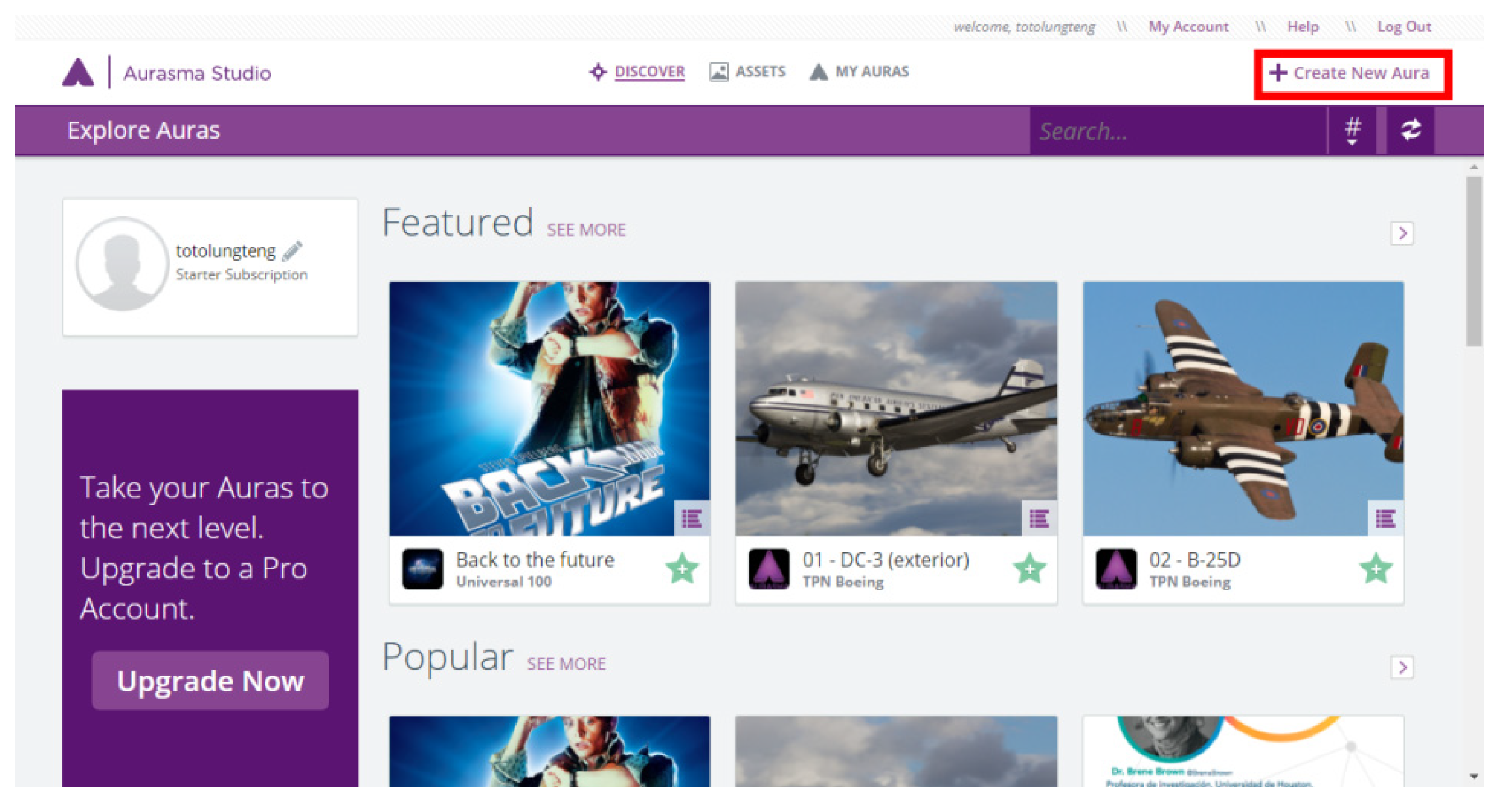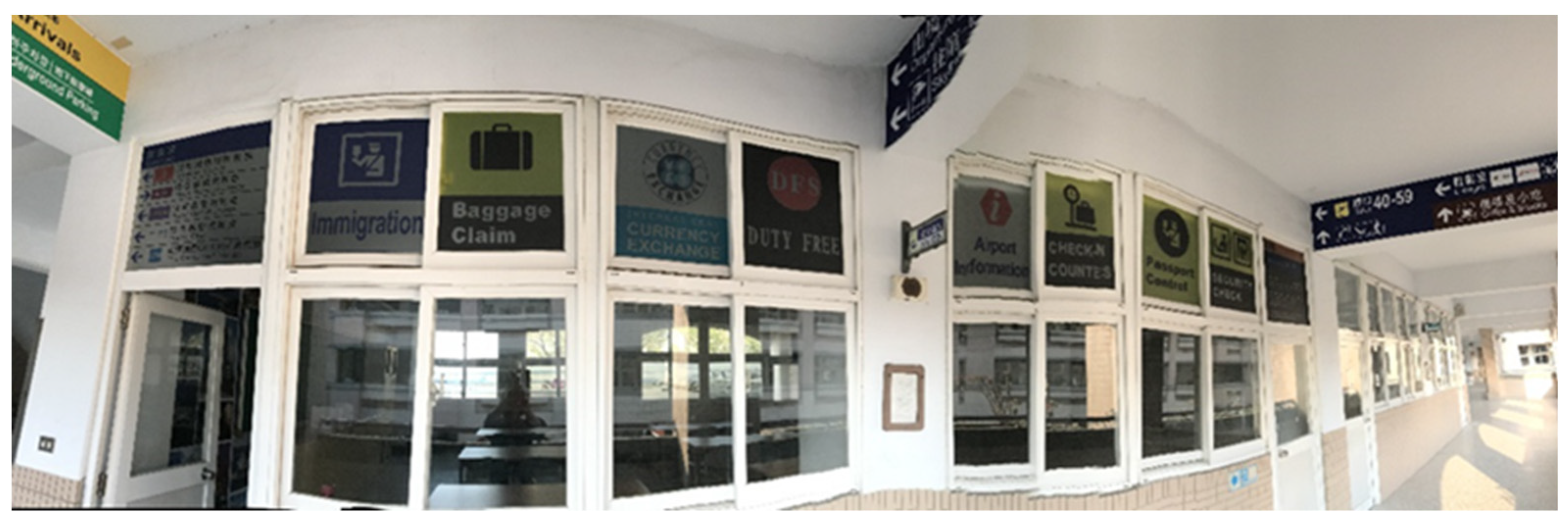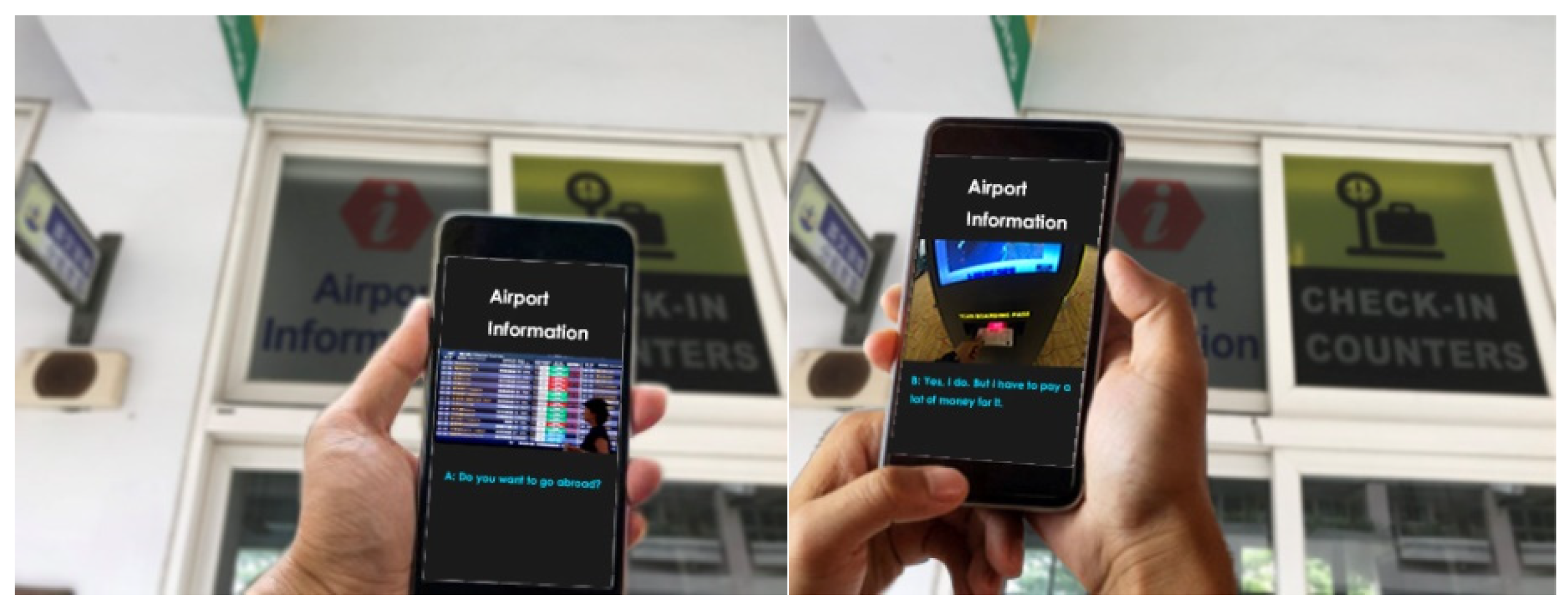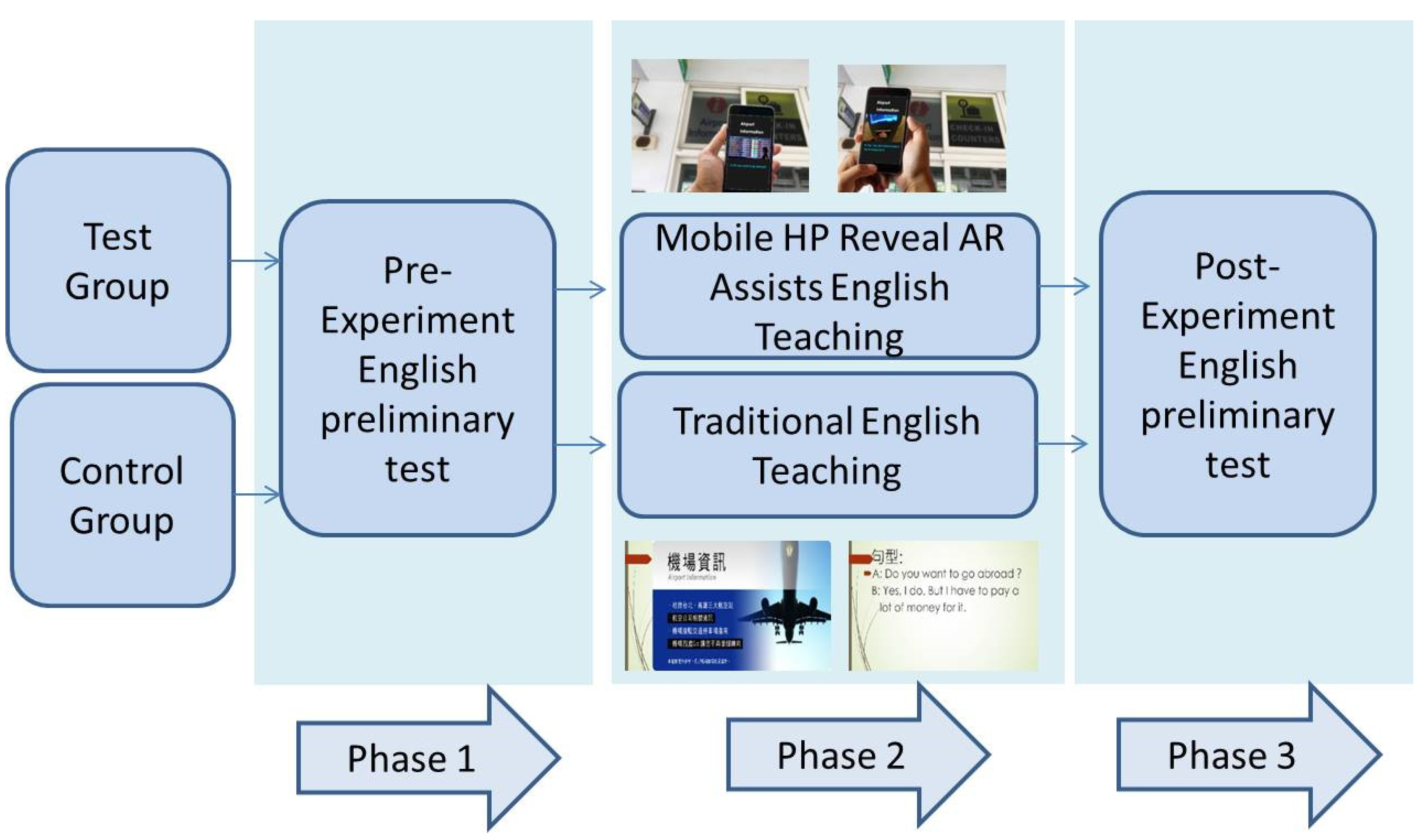Enhancing English-Learning Performance through a Simulation Classroom for EFL Students Using Augmented Reality—A Junior High School Case Study
Abstract
:1. Introduction
2. Literature Review
2.1. English Learning in the Digital Era
2.2. Situational Context of Learning
2.3. AR-Assisted English Learning
2.4. Learning Motivation Theory: The ARCS Model
3. Method
3.1. AR Experimental Teaching Design
3.2. Research Methods and Approach
- In the first phase, a pre-experiment English test was carried out, based on Harmer’s two indicators for checking English language proficiency [24]: language input (listening to and reading a received message) and language output (when the applied information is spoken and written). In the first week of the experimental teaching, we carried out English listening, speaking, reading, and writing tests in both groups.
- In the second phase, experimental teaching was carried out. In this stage, the experimental group received two courses of English teaching activities per week (40 min each). English lessons using the HP Reveal AR app were provided for the experimental group. The control group was taught using the traditional teaching approach. Both groups were taught in the situational context classroom.
- In the third phase, a post-experimental English test was carried out. After the 18th teaching week, the two groups (experimental group and reference group) were tested to verify the learning effect and the results of the experimental teaching method.
3.3. Participants
3.4. Questionnaire Design
4. Experimental Results
4.1. Evaluation of Learning Performance for Test and Control Group (Independent Sample t-Test Analysis)
4.2. Determination of the Learning Ability of both Test- and Control Groups
4.3. Single Factor Covariate Analysis for Post-Test
4.4. Concentration
5. Evaluation of Student Motivation through Questionnaires Related to the ARCS Model
- (1)
- Learning attitude for experimental group students was evaluated using the results of the concentration questionnaire. Based on the evaluation methods produced by Csikszentmihalyi [49] and Chambers [50], “immersed experiences” was modified into the part of “concentration” for the questionnaire. Concentration can be explained as a kind of “immersed experience” that occurs during the process of language learning; that is to say, interesting and enjoyable situational contexts lead to student immersion in the learning, in which their learning attitude becomes concentrated.
- (2)
- Learning interest can be referred to as a sort of inherent tendency, which is a part of a student’s individual characteristics. In general, people spend much more time and energy to do the things that they are interested in and satisfied with [51]. Learning interest refers to the state where students are satisfied and tend to spend more time and make more effort to learn. Thus, based on the observation of student interaction and practice in the four English listening, speaking, reading, and writing tasks during AR-assisted English learning, learning interest was then evaluated through the research questionnaire.
- (3)
- Learning behavior was considered, in this research, in order to confirm whether student confidence was enhanced by applying the AR technique, by determining whether student feedback on the AR-assisted English teaching program was positive. Chang et al. [5] stated that learning behavior can be used to measure whether students have improved their self-confidence after using AR. Moreover, Zheng et al. [44] pointed out that, during learning, confidence can be enhanced through the use of innovative teaching materials.
- (4)
- Satisfaction, in this research, was considered in order to evaluate the sense of satisfaction and the sense of accomplishment gained through the experimental teaching approach. Based on the statement of Zheng et al. [44], we wanted to understand whether students agreed with the use of the new textbook AR approach, as well as their inner perception of the degree of like or dislike of AR.
5.1. Reliability and Validity of the Analysis
5.2. Validity Analysis
5.3. Analysis of the Correlation Coefficients
- There was a significant positive correlation between the “Concentration of learning attitude” in the experimental group and the “learning interest on AR teaching design,” with a correlation coefficient of 0.59(**);
- The “learning interest on AR teaching design” and “confidence of learning behavior” in the experimental group were significantly positively correlated, with a correlation coefficient of 0.518(**);
- There was a significant positive correlation between “learning interest on AR teaching design” and “learning satisfaction” in the experimental group, with a correlation coefficient of 0.568(**); and
- “Learning interest on AR teaching design” and “learning effectiveness” in the experimental group showed a significant positive correlation, with a correlation coefficient of 0.485(**).
5.4. Research Hypothesis Validity
- Function 1: Learning attitude = f {Learning interest}—According to the ARCS theory proposed by Keller, the factors influencing learning interest are teaching methods and textbook design in environmental factors (referred to as “textbook design” in this study). Among these, it was found that the “Learning interest” of AR textbook design positively affected the factor of “Learning attitude” in the experimental group students (β = 0.59, p = 0.005 < 0.05, R2 = 0.314). The explanatory power was 31.4%, reaching a significant level; thus, H1 is valid.
- Function 2: Learning behavior = f {Learning interest}—After statistical regression, “Learning interest” was one of the factors affecting the factor of “Learning behavior” (β = 0.518, p = 0.016 < 0.05, R2 = 0.23). It can be seen that the Learning interest of AR textbook design positively affected the factor of “learning behavior” in the experimental group students, reaching a significant level. Thus, H2 is valid. It can be seen that the students in the experimental group were affected by the AR teaching design, in terms of learning behavior.
- Function 3: Learning satisfaction = f {Learning interest}—After statistical regression, “Learning interest” was one of the factors affecting the learning satisfaction (β = 0.555, p = 0.009 < 0.05, R2 = 0.272). It can be seen that the learning interest of AR textbook design positively affected the factor of “learning satisfaction” in the experimental group students, reaching a significant level. Thus, H3 is valid. It can be seen that the learning satisfaction of the experimental group students was influenced by the interest in the AR textbook design.
- Function 4: Learning effectiveness = f {Learning interest}—After statistical regression, “teaching material design” was one of the factors affecting learning outcomes (β = 0.445, p = 0.043 < 0.05, R2 = 0.156). It can be seen that the learning interest of AR textbook design positively affected the factor of “learning effectiveness” in the experimental group students, reaching a significant level. Thus, H4 is valid. It can be seen that the learning outcomes of the experimental group students were influenced by their interest in the AR textbook design.
6. Discussion
- The learning interest of students created in the process of AR-assisted English textbook learning was as expected before and after conducting the research. Thus, Research Hypothesis 1 was confirmed and accepted (as mentioned in Section 5.4); that is, learning interest created by AR teaching materials can have a positive influence on student concentration. In this research, we used airport themes for situational context teaching. In the AR teaching design, the students used smartphones to scan trigger images of airport situational contexts in the classroom and obtained airport-related real-life scenario conversation videos for communication learning. The key point is still whether AR-based teaching content can meet the needs of real-world conversation. Moreover, we have proved that innovative technology can change the teaching approach, as well as the learning style. E-learning using AR is the best example, which has allowed students freedom and convenience by learning using their mobile devices; thus, students can easily become immersed in the situational context E-learning program.
- Game elements in AR techniques have been considered as a research topic in numerous AR studies [13,35,36]. Unlike the previous integration of AR into teaching studies, we considered the learning interest created by AR situational context teaching materials as the independent variable, in order to examine the difference between two groups. The main reason for this is that we wanted to understand the influence of using AR to establish a learning environment on the learning effectiveness. Based on the results of linear regression coefficient analysis, we can conclude that AR-assisted English learning can have a positive impact on learning behavior, learning satisfaction, and learning effectiveness and that, during real-life scenario situational context teaching, student confidence and concentration can be enhanced. Thus, Research Hypothesis 2 was verified. Student satisfaction can be enhanced by use of an AR-assisted interactive English-speaking and listening conversation approach in a situational context teaching classroom. Thus, Hypothesis 3 was validated. Using the AR technique, the English teaching materials can be repeatedly played, thus providing an effective way for students to spontaneously learn and to enhance their English listening, speaking, reading, and writing competence. Thus, AR-assisted English learning can help to enhance learning performance and, so, Hypothesis 4 was also validated. The explanatory value of learning interest in terms of learning effectiveness was interpreted as R2 = 0.156. Because of the short-term (18 week) experimental teaching, the R2 value was low. Under this time limit, only three themes of situational teaching can be experienced, at most.
- The ARCS model has been emphasized and applied by numerous researchers for the study of learning effectiveness and learning motivation [30,44,53,54,55]. The ARCS learning motivation theory emphasizes individual characteristics and learning environments, which may affect a student’s willingness to make effort in learning and create a positive feedback cycle of learning effectiveness for the student. Stimulating interest in learning through instructional design is the key to providing an appropriate and interesting learning environment for students. Under this environment, students are likely to spontaneously make effort to learn, as their confidence is enhanced. This is the learning value emphasized by the ARCS learning motivation theory. Compared with students who have no interest in learning when taught using the traditional teaching approaches, the students who were taught using AR teaching materials may show better learning performance. Thus, among all the variables in ARCS, we took the AR teaching materials program design as the single-factor independent variable for analysis. However, in terms of AR-assisted English situational context classroom experimental teaching, Keller’s ARCS theory is in harmony with the findings of this research. We proved that Keller’s ARCS theory can be combined with the application of AR technology and applied to teaching practice in English situational classrooms.
7. Conclusions
Author Contributions
Funding
Conflicts of Interest
Appendix A
References
- Van Diggelen, M.R.; Bruns, M. Towards a vision for industrial design education. In Proceedings of the 43rd SEFI Annual Conference, Orléans, France, 29 June–2 July 2015. [Google Scholar]
- Clark, R.E. Reconsidering research on learning from media. Rev. Educ. Res. 1983, 53, 445–459. [Google Scholar] [CrossRef]
- Catrambone, R.; Seay, F.A. Using animations to help students learn computer algorithms. Human Factors 2002, 44, 495–511. [Google Scholar] [CrossRef] [PubMed]
- Hwang, W.; Shih, T.; Ma, Z.; Shadiev, R.; Chen, S. Evaluating listening and speaking skills in a mobile game-based learning environment with situational contexts. Comput. Assist. Lang. Learn. 2015, 29, 639–657. [Google Scholar] [CrossRef]
- Chang, Y.-S.; Hu, K.-J.; Chiang, C.-W.; Lugmayr, A. Applying Mobile Augmented Reality (AR) to Teach Interior Design Students in Layout Plans: Evaluation of Learning Effectiveness Based on the ARCS Model of Learning Motivation Theory. Sensors 2020, 20, 105. [Google Scholar] [CrossRef] [PubMed] [Green Version]
- Shadiev, R.; Yang, M. Review of Studies on Technology-Enhanced Language Learning and Teaching. Sustainability 2020, 12, 524. [Google Scholar] [CrossRef] [Green Version]
- Shadiev, R.; Sun, A.; Huang, Y.M. A study of the facilitation of cross-cultural understanding and intercultural sensitivity using speech-enabled language translation technology. Br. J. Educ. Technol. 2019, 50, 1415–1433. [Google Scholar] [CrossRef]
- Golonka, E.M.; Bowles, A.R.; Frank, V.M.; Richardson, D.L.; Freynik, S. Technologies for foreign language learning: A review of technology types and their effectiveness. Comput. Assist. Lang. Learn. 2014, 27, 70–105. [Google Scholar] [CrossRef]
- Cheon, H. The viability of computer mediated communication in the Korean secondary EFL classroom. Asian EFL J. 2003, 5, 1–61. [Google Scholar]
- Shadiev, R.; Hwang, W.Y.; Huang, Y.M.; Liu, C.J. Investigating applications of speech totext recognition for face to face seminar to assist learning of non-native English participants. Technol. Pedagog. Educ. 2016. [Google Scholar] [CrossRef]
- Tsou, W. Improving speaking skills through instruction in oral classroom participation. Foreign Lang. Ann. 2005, 38, 46–55. [Google Scholar] [CrossRef]
- Crescente, M.L.; Lee, D. Critical issues of m-learning: Design models, adoption processes, and future trends. J. Chinese Inst. Ind. Eng. 2011, 28, 111–123. [Google Scholar] [CrossRef]
- Hsu, T.C. Learning English with augmented reality: Do learning styles matter? Comput. Educ. 2017, 106, 137–149. [Google Scholar] [CrossRef]
- Ho, S.C.; Hsieh, S.W.; Sun, P.C.; Chen, C.M. To activate English learning: Listen and speak in real life context with an AR featured u-learning system. J. Educ. Technol. Soc. 2017, 20, 176–187. [Google Scholar]
- Munday, P. The Case for Using Duolingo as Part of the Language Classroom Experience. Rev. Iberoam. Educ. Distancia 2016, 19, 83–101. Available online: https://pdfs.semanticscholar.org/bb70/17902eb1bebb83aba5f5ad8637af7846a802.pdf (accessed on 12 June 2020). [CrossRef] [Green Version]
- GSMA. The Mobile Economy 2019. Available online: https://www.gsmaintelligence.com/research/?file=b9a6e6202ee1d5f787cfebb95d3639c5&download (accessed on 12 June 2020).
- Taiwan Communication Survey (TCS). The Survey on Mobile Phone Usage Habits of Taiwanese. 2019. Available online: http://www.crctaiwan.nctu.edu.tw/epaper/%E7%AC%AC90%E6%9C%9F20190815.htm (accessed on 15 June 2020).
- Duman, G.; Orhon, G.; Gedik, N. Research trends in mobile assisted language learning from 2000 to 2012. ReCALL 2015, 27, 197–216. [Google Scholar] [CrossRef]
- Griva, E.; Semoglou, K.; Geladari, A. Early foreign language learning: Implementation of a project in a game-based context. Procedia Soc. Behav. Sci. 2010, 2, 3700–3705. [Google Scholar] [CrossRef] [Green Version]
- Kinzie, M.B.; Joseph, D.R. Gender differences in game activity preferences of middle school children: Implications for educational game design. Educ. Technol. Res. Dev. 2008, 56, 643–663. [Google Scholar] [CrossRef]
- Norbrook, H.; Scott, P. Motivation in mobile modern foreign language learning. In MLEARN: Learning with Mobile Devices; Attewell, J., Da Bormida, G., Sharples, M., Savill-Smith, C., Eds.; Learning and Skills Development Agency: London, UK, 2003; pp. 50–51. [Google Scholar]
- Liu, T.Y.; Chu, Y.L. Using ubiquitous games in an English listening and speaking course: Impact on learning outcomes and motivation. Comput. Educ. 2010, 55, 630–643. [Google Scholar] [CrossRef]
- Folmar, D. Game It Up: Using Gamification to Incentivize Your Library; Rowman & Littlefield: Maryland, MD, USA, 2015; p. 5. [Google Scholar]
- Harmer, J. The Practice of English Language Teaching; Longman: London, UK, 2007; p. 1. [Google Scholar]
- Cohen, A.D. Comprehensible pragmatics: Where input and output come together. In New Perspectives on Individual Differences in Language Learning and Teaching; Pawlak, M., Ed.; Springer: Berlin/Heidelberg, Germany, 2012; pp. 249–261. [Google Scholar]
- Lightbown, P.M.; Spada, N. How Languages are Learned; Oxford University Press: Oxford, UK, 2006. [Google Scholar]
- Celce-Murcia, M. Rethinking the role of communicative competence in language teaching. In Intercultural Language Use and Language Learning; Soler, E.A., Jorda, M.P.S., Eds.; Springer: Dordrecht, The Netherlands, 2007; pp. 41–57. [Google Scholar]
- Ambient Insight. The 2016–2021 Worldwide Self-paced eLearning Market: Global eLearning Market in Steep Decline. 2017. Available online: https://uhlberg-advisory.de/wp-content/uploads/2017/06/AmbientInsight_The-2016-2021_Worldwide_Self-paced-eLearning_Market.pdf (accessed on 12 June 2020).
- Heil, C.R.; Wu, J.S.; Lee, J.J. A review of mobile language learning applications: Trends, challenges and opportunities. EuroCALL Rev. 2016, 24, 23–27. [Google Scholar] [CrossRef]
- Hwang, W.Y.; Chen, H.S.L.; Shadiev, R.; Huang, Y.M.; Chen, C.Y. Improving English as a foreign language writing in elementary schools using mobile devices in familiar situational contexts. Comput. Assist. Lang. Learn. 2014, 27, 359–378. [Google Scholar] [CrossRef]
- Burston, J. Twenty years of MALL project implementation: A meta-analysis of learning outcomes. ReCALL 2015, 27, 4. [Google Scholar] [CrossRef]
- Brisk, M.; Burgos, A.; Hamerla, S. A Window into the World of Bilingual Learners. In Situational Context of Education; Routledge: Abinden, UK, 2003; pp. 1–261. [Google Scholar] [CrossRef]
- Swartz, R.J.; Parks, S. Infusing the Teaching of Critical and Creative Thinking into Content Instruction; Critical Thinking & Software: Pacific Grove, CA, USA, 1994. [Google Scholar]
- MIT. Introducing TEAL (Technology-Enabled Active Learning). 2005. Available online: http://icampus.mit.edu/teal/ (accessed on 13 June 2020).
- Schrier, K. Using augmented reality games to teach 21st century skills. In ACM SIGGRAPH 2006 Educators Program (SIGGRAPH ‘06); Association for Computing Machinery: New York, NY, USA, 2006. [Google Scholar] [CrossRef]
- Cai, S.; Wang, X.; Chiang, F.-K. A case study of augmented reality simulation system application in a chemistry course. Comput. Human Behav. 2014, 37, 31–40. [Google Scholar] [CrossRef] [Green Version]
- Billinghurst, M.; Duenser, A. Augmented reality in the classroom. Computer 2012, 45, 56–63. [Google Scholar] [CrossRef]
- Feiner, S.K. Augmented reality: A new way of seeing. Sci. Am. 2002, 286, 48–55. [Google Scholar] [CrossRef]
- Mackay, W.E. Augmenting reality: A new paradigm for interacting with computers. La Rech. 1996, 33, 284. [Google Scholar]
- Khan, D.; Rehman, I.; Ullah, S.; Ahmad, W.; Cheng, Z.; Jabeen, G.; Kato, H. A Low-Cost Interactive Writing Board for Primary Education using Distinct Augmented Reality Markers. Sustainability 2019, 11, 5720. [Google Scholar] [CrossRef] [Green Version]
- Milgram, P.; Takemura, H.; Utsumi, A.; Kishimo, F. Augmented Reality: A Class of Displays on the Reality- Virtual Continuum. In Proceedings of the Telemanipulator and Telepresence Technologies, Boston, MA, USA, 31 October–1 November 1994; pp. 2334–2351. [Google Scholar]
- Fischer, G.; Scharff, E. Learning technologies in support of self-directed learning. J. Interact. Media Educ. 1998. [Google Scholar] [CrossRef] [Green Version]
- Keller, J.M. Motivational design of instruction. In Instructional Design Theories and Models: An Overview of Their Current Status; Reigeluth, C.M., Ed.; Lawrence Erlbaum Associates: Hillsdale, NJ, USA, 1983; pp. 386–434. [Google Scholar]
- Zheng, H.-W.; Chen, S.-T.; Fan, G.-G. Study on the Evaluation of Students’ Learning Movtivation Indicators from Using Facebook Communities—Talking the Culture Thinking and Creation of Digital Photography as an Example. Int. J. Digit. Media Des. 2019, 11, 17–32. [Google Scholar]
- Keller, J.M. Development and use of the ARCS model of instructional design. J. Instr. Dev. 1987, 10, 2–10. [Google Scholar] [CrossRef]
- Keller, J.M. Five fundamental requirements for motivation and volition in technology-assisted distributed learning environments. Rev. Inter Ação 2010, 35, 305–322. [Google Scholar] [CrossRef]
- Kintsch, W. Learning from text, levels of comprehension, or: Why anyone would read a story anyway. Poetics 1980, 9, 87–98. [Google Scholar] [CrossRef]
- HP Reveal. Available online: https://dgs.lungteng.com.tw/tf/tool.html?id=2 (accessed on 13 June 2020).
- Csikszentmihalyi, M. Beyond Boredom and Anxiety; Jossey-Bass: San Francisco, CA, USA, 1975. [Google Scholar]
- Chambers, A. The Reading Environment; Thimble Press: Stroud, UK, 1991. [Google Scholar]
- Krapp, A.; Hidi, S.; Renninger, K. Interest, learning, and development. In The Role of Interest in Learning and Development; Psychology Press: East Sussex, UK, 1992; pp. 3–25. [Google Scholar]
- Nunnally, J.C. Psychometric Theory; McGraw-Hill Series in Psychology; McGraw-Hill: New York, NY, USA, 1978; ISBN 9780070474659. [Google Scholar]
- Keller, J.M.; Suzuki, K. Use of ARCS Motivation Model in Courseware Design in Instructional Designs for Microcomputer Courseware; Erlbaum: Hillsdale, NJ, USA, 1998; pp. 34–40. [Google Scholar]
- Taran, C.N. Motivation techniques in eLearning. In Proceedings of the 5th IEEE International Conference on Advanced Learning Technologies, Kaohsiung, Taiwan, 5–8 July 2005; pp. 617–619. [Google Scholar] [CrossRef]
- Amin, I.M.; Isa, W.A.; Sidek, A.F.; Ibrahim, H.; Zulkipli, Z.A. Investigating motivational dimensions for e-learning: A case study of dental students. In Proceedings of the 2013 IEEE Business Engineering and Industrial Applications Colloquium (BEIAC), Langkawi, Malaysia, 7–9 April 2013; pp. 214–218. [Google Scholar]








| Element | Definition | Variable | Purpose |
|---|---|---|---|
| A Attitude | Arouse the interest of students, maintain the attention of students, and stimulate the curiosity of students. | Learning attention | 1. Whether students are immersed in AR to facilitate English learning. 2. Does the student concentrate on the learning experience with AR as the teaching material? 3. Observe student curiosity about the subject of learning, use time, and increase in concentration. |
| R Relevance | Students develop relevant personal recognition based on the learning of new textbooks and past experience. | Learning interest | 1. Use the learning materials provided by augmented reality (AR) to arouse student interest in learning. 2. How to make students feel that this course is worth studying and stimulate their interest in learning? |
| C Confidence | Arouse student’s expectations of success and positive attitudes towards themselves to help build self-confidence. | Learning behavior | 1. Students must use AR to master the steps of learning and be useful for learning. 2. Student confidence and concentration can be enhanced by AR teaching activities. |
| S Satisfaction | Student satisfaction and sense of accomplishment in the experience and results of learning will enhance their self-learning effectiveness. | Learning satisfaction | 1. Use AR to allow students to start self-learning, gain greater satisfaction and sense of accomplishment, and produce lasting learning interest. |
| Test Item | Group | Number of People | Pre-Test Average | Pre-Test Standard Deviation | Post-Measurement Average | Post-Test Standard Deviation |
|---|---|---|---|---|---|---|
| English test | Test group | 21 | 65.265 | 15.6122 | 78.810 | 15.9519 |
| Control group | 19 | 53.447 | 16.5461 | 54.421 | 28.2515 |
| Test Item | Source | SS | df | MS | F Value | Variability Homogeneity Test Significance |
|---|---|---|---|---|---|---|
| English test | SSB | 1242.432 | 1 | 1242.432 | 2.807 | 0.102 |
| in pre-test stage | SSW | 16817.343 | 38 | 442.562 | ||
| SST | 18059.775 | 39 |
| Test Item | Source | SS | df | MS | F Value | Significance |
|---|---|---|---|---|---|---|
| Post-test Difference between | SSB | 5933.105 | 1 | 5933.105 | 11.588 | 0.002 ** |
| SSW | 19,455.870 | 38 | 511.997 | |||
| groups | SST | 25,388.975 | 39 |
| Test Item | Source | SS | df | MS | F Value | Significance |
|---|---|---|---|---|---|---|
| learning concentration Difference between | SSB | 6.499 | 1 | 6.499 | 12.644 | 0.001 *** |
| SSW | 19.533 | 38 | 0.514 | |||
| groups | SST | 26.032 | 39 |
| Ingredients | Initial Eigenvalue | Rotation Square Sum of Factor Loadings | ||||
|---|---|---|---|---|---|---|
| Sum | Variance% | Cumulative% | Sum | Variance% | Cumulative% | |
| Learning interest | 7.804 | 39.019 | 39.019 | 4.251 | 21.257 | 21.257 |
| Learning attitude | 2.833 | 14.167 | 53.185 | 3.789 | 18.945 | 40.202 |
| Learning behavior | 2.545 | 12.724 | 65.909 | 3.424 | 17.118 | 57.320 |
| Learning satisfaction | 1.701 | 8.507 | 74.416 | 3.419 | 17.096 | 74.416 |
| Learning Attitude | Learning Interest | Learning Behavior | Learning Satisfaction | Learning Effectiveness | |
|---|---|---|---|---|---|
| Learning attitude Pearson Correlation | 1 | 0.590(**) | 0.306 | 0.618(**) | 0.822(**) |
| Significance (two-tailed) | 0.005 | 0.178 | 0.003 | 0.000 | |
| Learning interest Pearson Correlation | 0.590(**) | 1 | 0.518(*) | 0.568(**) | 0.485(*) |
| Significance (two-tailed) | 0.005 | 0.016 | 0.007 | 0.026 | |
| Learning behavior Pearson Correlation | 0.306 | 0.518(*) | 1 | 0.295 | 0.320 |
| Significance (two-tailed) | 0.178 | 0.016 | 0.194 | 0.157 | |
| Learning satisfaction Pearson Correlation | 0.618(**) | 0.568(**) | 0.295 | 1 | 0.509(*) |
| Significance (two-tailed) | 0.003 | 0.007 | 0.194 | 0.018 | |
| Learning effectiveness Pearson Correlation | 0.822(**) | 0.485(*) | 0.320 | 0.509(*) | 1 |
| Significance (two-tailed) | 0.000 | 0.026 | 0.157 | 0.018 |
Publisher’s Note: MDPI stays neutral with regard to jurisdictional claims in published maps and institutional affiliations. |
© 2020 by the authors. Licensee MDPI, Basel, Switzerland. This article is an open access article distributed under the terms and conditions of the Creative Commons Attribution (CC BY) license (http://creativecommons.org/licenses/by/4.0/).
Share and Cite
Chang, Y.-S.; Chen, C.-N.; Liao, C.-L. Enhancing English-Learning Performance through a Simulation Classroom for EFL Students Using Augmented Reality—A Junior High School Case Study. Appl. Sci. 2020, 10, 7854. https://doi.org/10.3390/app10217854
Chang Y-S, Chen C-N, Liao C-L. Enhancing English-Learning Performance through a Simulation Classroom for EFL Students Using Augmented Reality—A Junior High School Case Study. Applied Sciences. 2020; 10(21):7854. https://doi.org/10.3390/app10217854
Chicago/Turabian StyleChang, Yuh-Shihng, Chao-Nan Chen, and Chia-Ling Liao. 2020. "Enhancing English-Learning Performance through a Simulation Classroom for EFL Students Using Augmented Reality—A Junior High School Case Study" Applied Sciences 10, no. 21: 7854. https://doi.org/10.3390/app10217854
APA StyleChang, Y.-S., Chen, C.-N., & Liao, C.-L. (2020). Enhancing English-Learning Performance through a Simulation Classroom for EFL Students Using Augmented Reality—A Junior High School Case Study. Applied Sciences, 10(21), 7854. https://doi.org/10.3390/app10217854






